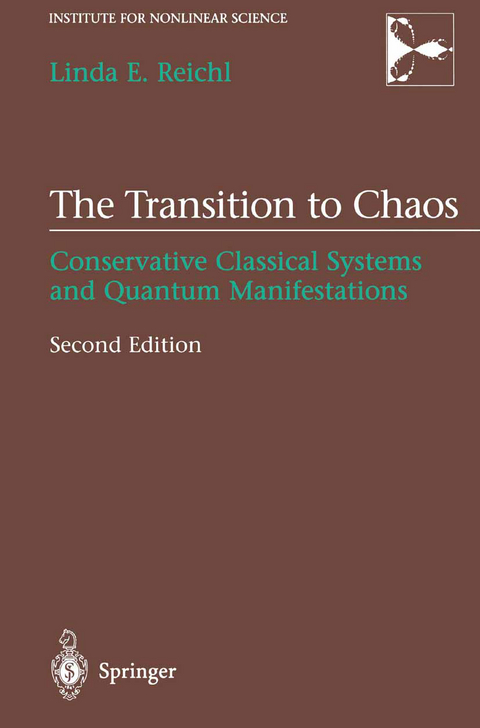
The Transition to Chaos
Springer-Verlag New York Inc.
9780387987880 (ISBN)
- Titel erscheint in neuer Auflage
- Artikel merken
1 Overview.- 2 Fundamental Concepts.- 3 Area-Preserving Maps.- 4 Global Properties.- 5 Random Matrix Theory.- 6 Bounded Quantum Systems.- 7 Manifestations of Chaos in Quantum Scattering Processes.- 8 Semiclassical Theory—Path Integrals.- 9 Time-Periodic Systems.- 10 Stochastic Manifestations of Chaos.- A Classical Mechanics.- A.1 Newton’s Equations.- A.2 Lagrange’s Equations.- A.3 Hamilton’s Equations.- A.4 The Poisson Bracket.- A.5 Phase Space Volume Conservation.- A.6 Action-Angle Coordinates.- A.7 Hamilton’s Principal Function.- A.8 References.- B Simple Models.- B.1 The Pendulum.- B.2 Double-Well Potential.- B.3 Infinite Square-Well Potential.- B.4 One-Dimensional Hydrogen.- B.4.1 Zero Stark Field.- B.4.2 Nonzero Stark Field.- C Renormalization Integral.- C.3 References.- D Moyal Bracket.- D.1 The Wigner Function.- D.2 Ordering of Operators.- D.3 Moyal Bracket.- D.4 References.- E Symmetries and the Hamiltonian Matrix.- E.1 Space-Time Symmetries.- E.1.1 Continuous Symmetries.- E.1.2 Discrete Symmetries.- E.2 Structure of the Hamiltonian Matrix.- E.2.1 Space-Time Homogeneity and Isotropy.- E.2.2 Time Reversal Invariance.- E.3 References.- F Invariant Measures.- F.1 General Definition of Invariant Measure.- F.1.1 Invariant Metric (Length).- F.1.2 Invariant Measure (Volume).- F.2 Hermitian Matrices.- F.2.1 Real Symmetric Matrix.- F.2.2 Complex Hermitian Matrices.- F.2.3 Quaternion Real Matrices.- F.2.4 General Formula for Invariant Measure of Hermitian Matrices.- F.3 Unitary Matrices.- F.3.1 Symmetric Unitary Matrices.- F.3.2 General Unitary Matrices.- F.3.3 Symplectic Unitary Matrices.- F.3.4 General Formula for Invariant Measure of Unitary Matrices.- F.3.5 Orthogonal Matrices.- F.4 References.- G Quaternions.- G.1 References.- H Gaussian Ensembles.- H.1Vandermonde Determinant.- H.2 Gaussian Unitary Ensemble (GUE).- H.3 Gaussian Orthogonal Ensemble (GOE).- H.4 Gaussian Symplectic Ensemble (GSE).- H.5 References.- I Circular Ensembles.- 1.1 Vandermonde Determinant.- 1.2 Circular Unitary Ensemble (CUE).- 1.3 Circular Orthogonal Ensemble (COE).- 1.4 Circular Symplectic Ensemble (COE).- 1.5 References.- J Volume of Invariant Measure for Unitary Matrices.- J.1 References.- K Lorentzian Ensembles.- K.1 Normalization of AOE.- K.2 Relation Between COE and AOE.- K.4 Invariance of AOE under Inversion.- K.4.1 Robustness of AOE under Integration.- K.5 References.- L Grassmann Variables and Supermatrices.- L.1 Grassmann Variables.- L.2 Supermatrices.- L.2.1 Transpose of a Supermatrix.- L.2.2 Hermitian Adjoint of a Supermatrix.- L.2.3 Supertrace of a Supermatrix.- L.2.4 Determinant of a Supermatrix.- L.3 References.- M Average Response Function (GOE).- M.3 Gaussian Integral for Response Function Generating Function.- M.4 Expectation Value of the Generating Function (Part 1).- M.5 The Hubbard-Stratonovitch Transformation.- M.6 Expectation Value of the Generating Function (Part 2).- M.7 Average Response Function Density.- M.7.1 Saddle Points for the Integration over a.- M.7.2 Saddle Points for the Integration over ?.- M.7.4 Wigner Semicircle Law.- M.8 References.- N Average S-Matrix (GOE).- N.1 S-Matrix Generating Function.- N.2 Average S-Matrix Generating Function.- N.3 Saddle Point Approximation.- N.4 Integration over Grassmann Variables.- N.5 References.- O Maxwell’s Equations for 2-d Billiards.- O.1 References.- P Lloyd’s Model.- P.1 Localization Length.- P.2 References.- Q Hydrogen in a Constant Electric Field.- Q.1 The Schrödinger Equation.- Q.1.1 Equation for Relative Motion.- Q.2 One-Dimensional Hydrogen.- Q.3References.- Author Index.
| Reihe/Serie | Institute for Nonlinear Science |
|---|---|
| Zusatzinfo | 154 Illustrations, black and white; XVIII, 675 p. 154 illus. |
| Verlagsort | New York, NY |
| Sprache | englisch |
| Maße | 155 x 235 mm |
| Themenwelt | Mathematik / Informatik ► Informatik ► Theorie / Studium |
| Naturwissenschaften ► Physik / Astronomie ► Astronomie / Astrophysik | |
| Naturwissenschaften ► Physik / Astronomie ► Mechanik | |
| Naturwissenschaften ► Physik / Astronomie ► Quantenphysik | |
| Naturwissenschaften ► Physik / Astronomie ► Theoretische Physik | |
| Naturwissenschaften ► Physik / Astronomie ► Thermodynamik | |
| ISBN-13 | 9780387987880 / 9780387987880 |
| Zustand | Neuware |
| Informationen gemäß Produktsicherheitsverordnung (GPSR) | |
| Haben Sie eine Frage zum Produkt? |
aus dem Bereich


